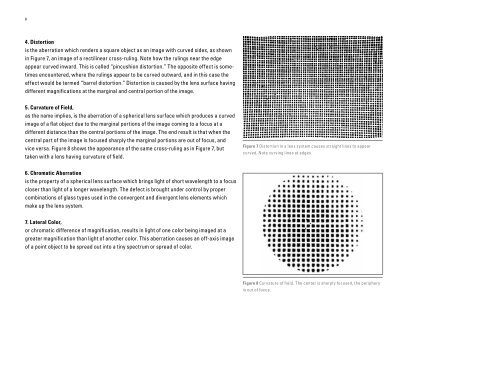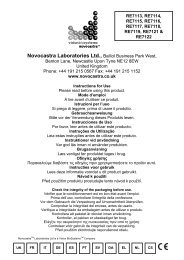The Theory of the Microscope - Leica Microsystems
The Theory of the Microscope - Leica Microsystems
The Theory of the Microscope - Leica Microsystems
Create successful ePaper yourself
Turn your PDF publications into a flip-book with our unique Google optimized e-Paper software.
8<br />
4. Distortion<br />
is <strong>the</strong> aberration which renders a square object as an image with curved sides, as shown<br />
in Figure 7, an image <strong>of</strong> a rectilinear cross-ruling. Note how <strong>the</strong> rulings near <strong>the</strong> edge<br />
appear curved inward. This is called “pincushion distortion.” <strong>The</strong> opposite effect is sometimes<br />
encountered, where <strong>the</strong> rulings appear to be curved outward, and in this case <strong>the</strong><br />
effect would be termed “barrel distortion.” Distortion is caused by <strong>the</strong> lens surface having<br />
different magnifications at <strong>the</strong> marginal and central portion <strong>of</strong> <strong>the</strong> image.<br />
5. Curvature <strong>of</strong> Field,<br />
as <strong>the</strong> name implies, is <strong>the</strong> aberration <strong>of</strong> a spherical lens surface which produces a curved<br />
image <strong>of</strong> a flat object due to <strong>the</strong> marginal portions <strong>of</strong> <strong>the</strong> image coming to a focus at a<br />
different distance than <strong>the</strong> central portions <strong>of</strong> <strong>the</strong> image. <strong>The</strong> end result is that when <strong>the</strong><br />
central part <strong>of</strong> <strong>the</strong> image is focused sharply <strong>the</strong> marginal portions are out <strong>of</strong> focus, and<br />
vice versa. Figure 8 shows <strong>the</strong> appearance <strong>of</strong> <strong>the</strong> same cross-ruling as in Figure 7, but<br />
taken with a lens having curvature <strong>of</strong> field.<br />
6. Chromatic Aberration<br />
is <strong>the</strong> property <strong>of</strong> a spherical lens surface which brings light <strong>of</strong> short wavelength to a focus<br />
closer than light <strong>of</strong> a longer wavelength. <strong>The</strong> defect is brought under control by proper<br />
combinations <strong>of</strong> glass types used in <strong>the</strong> convergent and divergent lens elements which<br />
make up <strong>the</strong> lens system.<br />
7. Lateral Color,<br />
or chromatic difference <strong>of</strong> magnification, results in light <strong>of</strong> one color being imaged at a<br />
greater magnification than light <strong>of</strong> ano<strong>the</strong>r color. This aberration causes an <strong>of</strong>f-axis image<br />
<strong>of</strong> a point object to be spread out into a tiny spectrum or spread <strong>of</strong> color.<br />
Figure 7 Distortion in a lens system causes straight lines to appear<br />
curved. Note curving lines at edges.<br />
Figure 8 Curvature <strong>of</strong> field. <strong>The</strong> center is sharply focused, <strong>the</strong> periphery<br />
is out <strong>of</strong> focus.

















